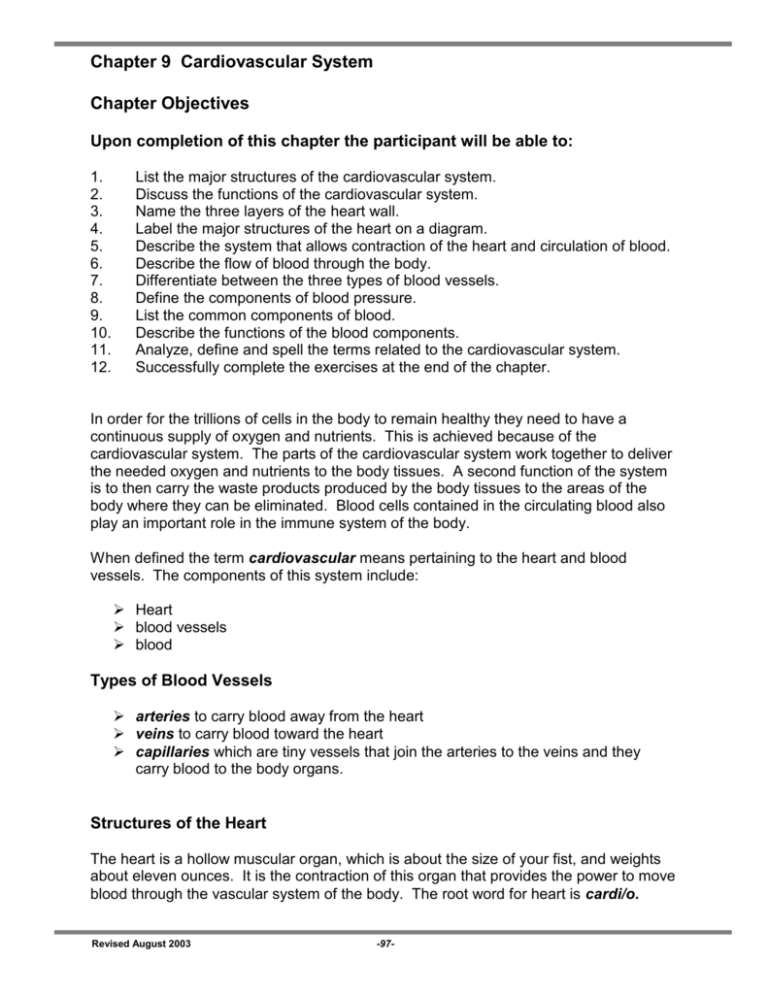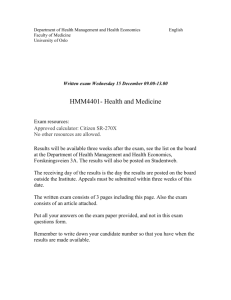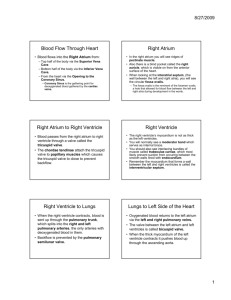Chapter 9 Cardiovascular System
advertisement

Chapter 9 Cardiovascular System Chapter Objectives Upon completion of this chapter the participant will be able to: 1. 2. 3. 4. 5. 6. 7. 8. 9. 10. 11. 12. List the major structures of the cardiovascular system. Discuss the functions of the cardiovascular system. Name the three layers of the heart wall. Label the major structures of the heart on a diagram. Describe the system that allows contraction of the heart and circulation of blood. Describe the flow of blood through the body. Differentiate between the three types of blood vessels. Define the components of blood pressure. List the common components of blood. Describe the functions of the blood components. Analyze, define and spell the terms related to the cardiovascular system. Successfully complete the exercises at the end of the chapter. In order for the trillions of cells in the body to remain healthy they need to have a continuous supply of oxygen and nutrients. This is achieved because of the cardiovascular system. The parts of the cardiovascular system work together to deliver the needed oxygen and nutrients to the body tissues. A second function of the system is to then carry the waste products produced by the body tissues to the areas of the body where they can be eliminated. Blood cells contained in the circulating blood also play an important role in the immune system of the body. When defined the term cardiovascular means pertaining to the heart and blood vessels. The components of this system include: Heart blood vessels blood Types of Blood Vessels arteries to carry blood away from the heart veins to carry blood toward the heart capillaries which are tiny vessels that join the arteries to the veins and they carry blood to the body organs. Structures of the Heart The heart is a hollow muscular organ, which is about the size of your fist, and weights about eleven ounces. It is the contraction of this organ that provides the power to move blood through the vascular system of the body. The root word for heart is cardi/o. Revised August 2003 -97- The heart is located in the middle of the chest behind the breastbone (sternum) and between the lungs. It is in the thoracic cavity and slightly more on the left side than the right. The heart lies within a fluid filled sac called the pericardium. There are three layers to the walls of the heart: epicardium, myocardium and the endocardium. The major structures of the heart are labeled in the diagram below. Superior Vena Cava Aorta Pulmonary Artery Pulmonary Veins Left Atrium Pulmonary Valve Right Atrium Mitral Valve Tricuspid Valve Left Ventricle Right Ventricle Septum Inferior Vena Cava Structures of the Heart Atria: There are two atria .... the left atrium and the right atrium. They are the two receiving chambers for blood and all blood vessels coming into the heart enters here. The root for artium is atri/o. Blood from the body circulates back into the heart through the right atrium while the left atrium receives blood from the lungs. Ventricles: There are two ventricles .... the right ventricle and the left ventricle. Blood moves from the right atrium into the right ventricle and is then pumped to Revised August 2003 -98- the lungs where CO2 (carbon dioxide) is eliminated and O2 (oxygen) is absorbed. When the blood arrives back at the heart it enters the left atrium and then passes into the left ventricle. Once there the ventricle will contract and send the blood to all parts of the body. The root for ventricle is ventricul/o. Septum: The tissue that separates the left side of the heart from the right. Valves: The flow of blood through the heart is controlled by a series of one-way valves (valv/o, valvul/o). These valves are: o Tricuspid valve: Separates the right atrium from the right ventricle. o Pulmonary valve: Between the right ventricle and the pulmonary artery. o Mitral valve: Separates the left atrium from the left ventricle. o Aortic valve: Between the left ventricle and the aorta. Vessels: There are a series of veins (ven/o, phleb/o) and arteries (arteri/o) which enter and leave the heart. These vessels are the: o Superior vena cava: Large vein that carries blood from the upper part of the body to the right atrium. o Inferior vena cava: Large vein that carries blood from the lower part of the body to the right atrium. o Pulmonary artery: Carries blood from the right ventricle to the lungs. o Pulmonary veins: Carries blood from the lungs to the left atrium. o Aorta: Large artery that carries blood from the left ventricle to all the body parts (aort/o) Coronary arteries: The heart muscle like all other body muscles requires oxygen and nutrients to live. To carry blood to the heart muscle itself there is a series of coronary arteries (coron/o) that encircle the heart. Heart Function The heart normally contracts and relaxes about 70 to 80 times per minute. With each beat it is delivering oxygen rich blood to the cells of the body and at the same time picks up any waste products produced by the cells. At the end of the day the heart has pumped about 4300 gallons of blood. Revised August 2003 -99- Blood Circulation Lung s Pulmonary Artery Pulmonary Vein Aorta Vena Cava Heart Body Tissue Blood Flow Through the Heart The right atrium receives blood from all tissues, except the lungs, through the superior and inferior vena cava. Blood flows from here through the tricuspid valve into the right ventricle. The right ventricle pumps the blood through the pulmonary valve and into the pulmonary artery, which carries it to the lungs. The left atrium receives oxygenated blood from the lungs through the pulmonary veins. The blood flows through the mitral valve into the left ventricle. The left ventricle receives blood from the left atrium. From the left ventricle blood goes out through the aortic valve and into the aorta and is pumped to all parts of the body, except the lungs. Blood is returned by the vena cava to the right atrium and the cycle begins again. Revised August 2003 -100- Conduction System The heart beats because of an ongoing electrical system called the conduction system. This system consists of a network of muscle cells that transmit an electrical current that causes the various parts of the heart muscle to contract. The rate and regularity of the heart contracting/beating is the result of this conduction system, which consists of: sinoatrial node (SA node): Starts the electrical impulse which sets the rhythm of the heart beat. Because of this it is referred to as the “pacemaker” of the heart. It usually stimulates 60 - 95 beats per minute. atrioventricular node (AV node): Impulse from SA node is transmitted to the AV node in the walls of the right atrium. This causes both the right and left atria to contract at the same time. AV bundle: Impulse moves from the AV node to the AV bundle. Purkinje fibers: Impulse moves from the AV bundle to the Purkinje fibers. These fibers then stimulate both ventricles to contract at the same time. The electrical activity of the heart can be monitored using an electrocardiogram (ECG, EKG). This machine will produce a graphic picture of the electrical activity of the heart and allows the physician to diagnose problems in the heart. The functioning of the heart can also be assessed by taking the blood pressure, listening to the sounds of the heart, and counting the heart beats. Measuring blood pressure is measuring the amount of pressure the blood exerts on the walls of the arteries. When your blood pressure is taken you receive a reading that is recorded as one number over another: e.g. 100/60 to 120/80 (normal blood pressure range). The top number is referred to as the systolic pressure, and is the amount of pressure on the arteries when the ventricles are contracting. The bottom number is the diastolic pressure, and is the amount of pressure on the walls when the ventricles are relaxed. High blood pressure is referred to as hypertension while low blood pressure is termed hypotension. The machine which you use to take blood pressure is called a sphygmomanometer (sfig-moh-man-om-eh-ter) When a stethoscope is placed over the heart the sounds made by the heart are magnified and can be heard. It sounds like “lupp” “dub”. These sounds are produced by the closing of the valves in the heart. The Blood The blood that circulates in the blood vessels is referred to as “whole blood” and is about 55% liquid and 45% solid. The liquid part is referred to as plasma. The solid, or cellular portion consists of red blood cells (erythrocytes), white blood cells (leukocytes) and platelets (thrombocytes). The plasma portion of the blood is made up of 90% water and results in the blood being liquid. In addition to carrying the blood cells throughout the body the blood also transports fats, proteins, gases, salts and the hormones of the endocrine system. Revised August 2003 -101- Blood cells start as cells called hemocytoblasts. As they mature through a process called hematopoiesis the cells will become red cells, white cells or platelets. Erythrocytes contain a protein called hemoglobin that makes it possible for the cells to absorb oxygen and carry it through the blood to the body cells that need it to sustain life. Leukocytes are the blood cells that fight infections. They have the ability to move from the blood stream into the tissue that is infected, and fight the disease process. The types of white blood cells are: esinophils basophils neutrophils monocytes lymphocyes Thrombocytes, or platelets are the third type of cell. These cells start blood clotting when bleeding occurs. The platelet acts by releasing prothrombin and fibrinogen which creates a plug or mesh network that stops the area from bleeding. Blood Type and Blood Donation Blood Type Can Donate Blood To Can Receive Blood From A A or AB only A or O only B B or AB only B or O only AB (Universal recipient) AB only A, B, AB, O O (Universal donor) A, B, AB, O O only When a blood transfusion is being considered, as well as the blood type a second factor must be assessed. The Rh factor is a component of the red blood cell of most people (85%). If you have the factor you are Rh positive and if not you are Rh negative. Knowing whether or not you have the factor is also of importance in women who are pregnant. Word Parts for the Cardiovascular System Roots angi/o, vascul/o, vas/o aort/o arteri/o ather/o atri/o cardi/o coron/o Revised August 2003 vessel aorta artery fatty debris, fatty plaque atrium heart crown (coronary arteries) -102- ech/o erythr/o fibrin/o hem/o, hemat/o isch/o leuk/o lip/o macr/o micr/o my/o phag/o phleb/o, ven/o rhythm/o ser/o tensi/o thromb/o valvul/o, valv/o ventricul/o sound red fibrin blood hold back white fat large small muscle eating, swallowing vein rhythm serum tension clot valve ventricle Prefixes bradyendoepiperprotachy- slow within upper through before fast Sufixes -blast -crit -cyte -cytosis -ectasis -emia -penia -phage -poiesis, -poietin -spasm -stasis immature separate cell condition of cells dilation blood deficiency cell that destroys formation spasm or contraction stoppage Term Analysis and Definition Word Part Term angi/o vascul/o angiectasis Revised August 2003 Analysis angi = vessel -ectasis = dilation -103- Definition Dilation of a vessel. Word Part Term Analysis Definition angiography -graphy = create a graphic picture Process of recording blood vessels using X-Ray. vasculoplasty vascul = vessel -plasty = surgical repair Surgical repair of a vessel. vascular -ar = pertaining to Pertaining to a vessel. aort/o aortostenosis aort = aorta -stenosis = narrowing Narrowing of the aorta. arteri/o arteriole arteri = artery -ole = small -sclerosis = hardening Small arteries. endo = within -ectomy Surgical removal of the inner lining of the artery. arteriosclerosis endarterectomy Hardening of the arteries. = surgical removal ather/o atherosclerosis ather = fatty plaque -sclerosis = hardening Hardening of the arteries by an accumulation of fatty plaque on the inner arterial walls. atri/o interatrial inter = between -al = pertaining to atri = atrium Pertaining to the area between the atrium. cardi/o cardiology cardi = heart -logy = study of Study of the heart including diseases and treatment. cardiologist -logist = specialist Specialist in the study of the heart. cardiomegaly -megaly = enlargement Enlargement of the heart cardiomyopathy my = muscle -pathy = condition Disease of the heart muscle myocardial my = muscle -al = pertaining to Pertaining to the heart muscle pericarditis peri = around -itis = inflammation Inflammation around the heart. Revised August 2003 -104- Word Part Term Analysis Definition chrom/o hyperchromia hyper = excessive chrom = color -ia = condition Excessive pigmentation of the blood cells coron/o coronary arteries coron = crown -ary = pertaining to Pertaining to the arteries that supply the heart with blood. (The coronary arteries sit on top of the heart like a crown). eryth/o erythrocyte eryth = red -cyte = cell Red blood cell hemat/o, hem/o hemolysis hem = blood -lysis = breakdown Breakdown of blood hematologist hemat = blood -logist = specialist Specialist in diseases of the blood. hematology -logy = study of Study of the blood and blood disorders leuk/o leukocyte leuk = white -cyte = cell White blood cell myel/o myelogenous myel = bone marrow -genous = produced by Produced by the bone marrow. rhythm/o arrhythmia a = no, not rhythm = rhythm -ia = state of Deviation from the normal heart rhythm thromb/o thrombocyte thromb = clot -cyte = cell Clotting cell thrombolysis -lysis = breakdown Breakdown of a clot thrombosis -osis = abnormal condition Abnormal condition of clot formation valvul/o valvuloplasty valvul = valve -plasty = surgical repair Surgical repair of a valve ventricul/o interventricular inter = between -ar = pertaining to ventricul = ventricle Pertaining to the area between the ventricles Revised August 2003 -105- Word Part Term -blast hemocytoblast hem = blood cyt = cell -blast = immature Immature blood cell lymphoblast lymph = lymph Immature lymphocyte -brady bradycardia brady = slow cardi = heart -ia = condition Condition of slow heart rate -crit hematocrit hemat = blood -crit = separate Lab test that separates the blood into its parts. -cytosis leukocytosis leuk = white -cytosis = increase in the number of cells Marked increase in the number of white blood cells -emia anemia a = no, not, lack of -emia = blood Lack of red blood cells erythremia erythr = red Abnormal increase in the number of red cells leukemia leuk = white Increase in the number of white blood cells in the blood. Considered a form of cancer. erythrocytopenia erythr = red cyt = cell -penia = decrease, deficiency Decrease in the number of red cells leukocytopenia leuk = white Decrease in the number of white blood cells thrombocytopenia thromb = clot Decrease in the number of clotting cells pancytopenia pan = all Decrease in the number of all blood cells erythropoiesis erythr = red -poiesis = production, formation Production of red blood cells -penia -poiesis, -poietin Revised August 2003 Analysis -106- Definition Word Part Term Analysis Definition hematopoiesis hemat = blood Production of blood cells -stasis hemostasis hemo = blood -stasis = stopping, controlling Stoppage of blood -tachy tachycardia tachy = fast cardi = heart -ia = condition Condition of fast heart rate Vocabulary Words: Aneurysm A sac formed by a local widening of the wall of an artery or a vein; usually caused by injury or disease Bruit a sound of venous or arterial origin heard on auscultation Claudication The process of lameness, limping; may result from inadequate blood supply to the muscles in the leg Diastole The relaxation phase of the heart cycle during which the heart muscle relaxes and the heart chambers fill with blood Embolism a moving blood clot Fibrillation Quivering of muscle fiber; may be atrial or ventricular Hypertension high blood pressure Infarction Process of development of an infarct, which is necrosis of tissue resulting from obstruction of blood flow Murmur A soft blowing sound heard on auscultation of various parts of the body, especially the region of the heart Palpitation Rapid throbbing or fluttering of the heart Systole The contractive phase of the heart cycle during which blood is forced in the the aorta and the pulmonary artery Thrombosis a stationary blood clot Abbreviations: AMI acute myocardial infarction ASD atrial septal defect Revised August 2003 -107- ASHD arteriosclerotic heart disease BP blood pressure CAD coronary artery disease CHF congestive heart failure CPR cardiopulmonary resuscitation DVTs deep vein thromboses ECG electrocardiogram MI myocardial infarction PVCs premature ventricular contractions RA right atrium RV right ventricle Revised August 2003 -108-




